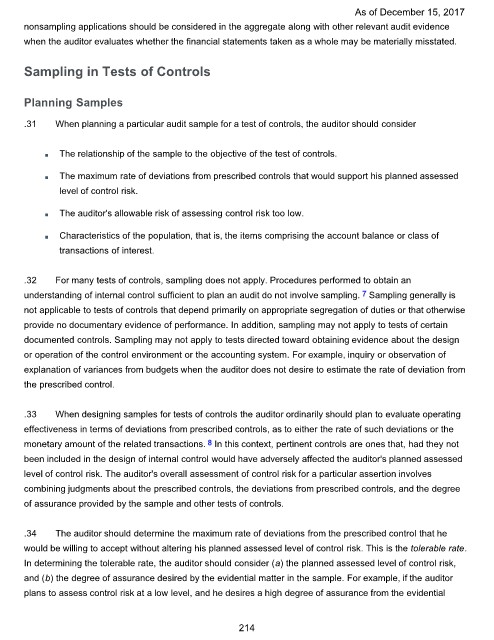Page 217 - Auditing Standards
P. 217
As of December 15, 2017
nonsampling applications should be considered in the aggregate along with other relevant audit evidence
when the auditor evaluates whether the financial statements taken as a whole may be materially misstated.
Sampling in Tests of Controls
Planning Samples
.31 When planning a particular audit sample for a test of controls, the auditor should consider
The relationship of the sample to the objective of the test of controls.
The maximum rate of deviations from prescribed controls that would support his planned assessed
level of control risk.
The auditor's allowable risk of assessing control risk too low.
Characteristics of the population, that is, the items comprising the account balance or class of
transactions of interest.
.32 For many tests of controls, sampling does not apply. Procedures performed to obtain an
7
understanding of internal control sufficient to plan an audit do not involve sampling. Sampling generally is
not applicable to tests of controls that depend primarily on appropriate segregation of duties or that otherwise
provide no documentary evidence of performance. In addition, sampling may not apply to tests of certain
documented controls. Sampling may not apply to tests directed toward obtaining evidence about the design
or operation of the control environment or the accounting system. For example, inquiry or observation of
explanation of variances from budgets when the auditor does not desire to estimate the rate of deviation from
the prescribed control.
.33 When designing samples for tests of controls the auditor ordinarily should plan to evaluate operating
effectiveness in terms of deviations from prescribed controls, as to either the rate of such deviations or the
8
monetary amount of the related transactions. In this context, pertinent controls are ones that, had they not
been included in the design of internal control would have adversely affected the auditor's planned assessed
level of control risk. The auditor's overall assessment of control risk for a particular assertion involves
combining judgments about the prescribed controls, the deviations from prescribed controls, and the degree
of assurance provided by the sample and other tests of controls.
.34 The auditor should determine the maximum rate of deviations from the prescribed control that he
would be willing to accept without altering his planned assessed level of control risk. This is the tolerable rate.
In determining the tolerable rate, the auditor should consider (a) the planned assessed level of control risk,
and (b) the degree of assurance desired by the evidential matter in the sample. For example, if the auditor
plans to assess control risk at a low level, and he desires a high degree of assurance from the evidential
214

